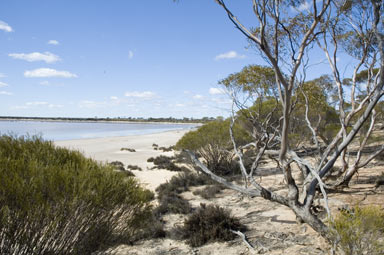 Salt lake fringed by Melaleuca shrubs and mallee, Lake Gilles, SA |
 Claypan with canegrass, Eragrostis australasica, with surface water after rain, western NSW |
Claypans, salt lakes, samphires, bare areas
- Desert claypans form shallow temporary lakes after rainfall.
- These lakes are highly variable, both spatially and temporally in terms of their salt concentration - this in turn has a pronounced influence over the type and amount of vegetation present at any one site.
- Although some individual lakes are themselves extensive (e.g. Lake Eyre in South Australia), inland salt lakes together comprise only a very small proportion of the Australian desert landscape.
- Lake Eyre is the world's largest salt-lake,
covering about 9690 square kilometres.
- In damp and water-logged areas (e.g. on drainage
areas and fringing salt lake areas) samphires
dominate the overstorey.
- Species in samphire communities include the Chenopodiaceae genera Halosarcia, Salicornia, Sclerostegia, Sueda and Sarcocornia genera. Extensive areas of samphires are treated as Chenopod Shrubland in the Photograph Index.
The ability to tolerate both high salt concentrations and desiccation are critical requirements for any plant to survive salt lake habitats.
![]() Photos from the Australian Plant Image Index
Photos from the Australian Plant Image Index

Sources: Australia's Native Vegetation - from rainforest to spinifex, map and information poster produced by the National Land & Water Audit, Natural Heritage Trust, Australian Government, 2001
Australia's Native Vegetation - A summary of Australia's Major Vegetation Groups, 2007, Australian Government website
Map: https://www.environment.gov.au/system/files/resources/a9897cf2-9d38-4201-bea2-13dadf3af9a8/files/major-veg-summary.pdf
Text: ABS 2006, http://www.abs.gov.au/ausstats/abs@.nsf/Previousproducts/1301.0Feature%20Article42006?opendocument
http://www.environment.gov.au/system/files/resources/17345e0a-40dc-4cae-97d3-e972c52c4ea7/files/vegfsheet-mvg22.pdf
![An Australian Government Initiative [logo]](/images/austgovt_brown_90px.gif)

